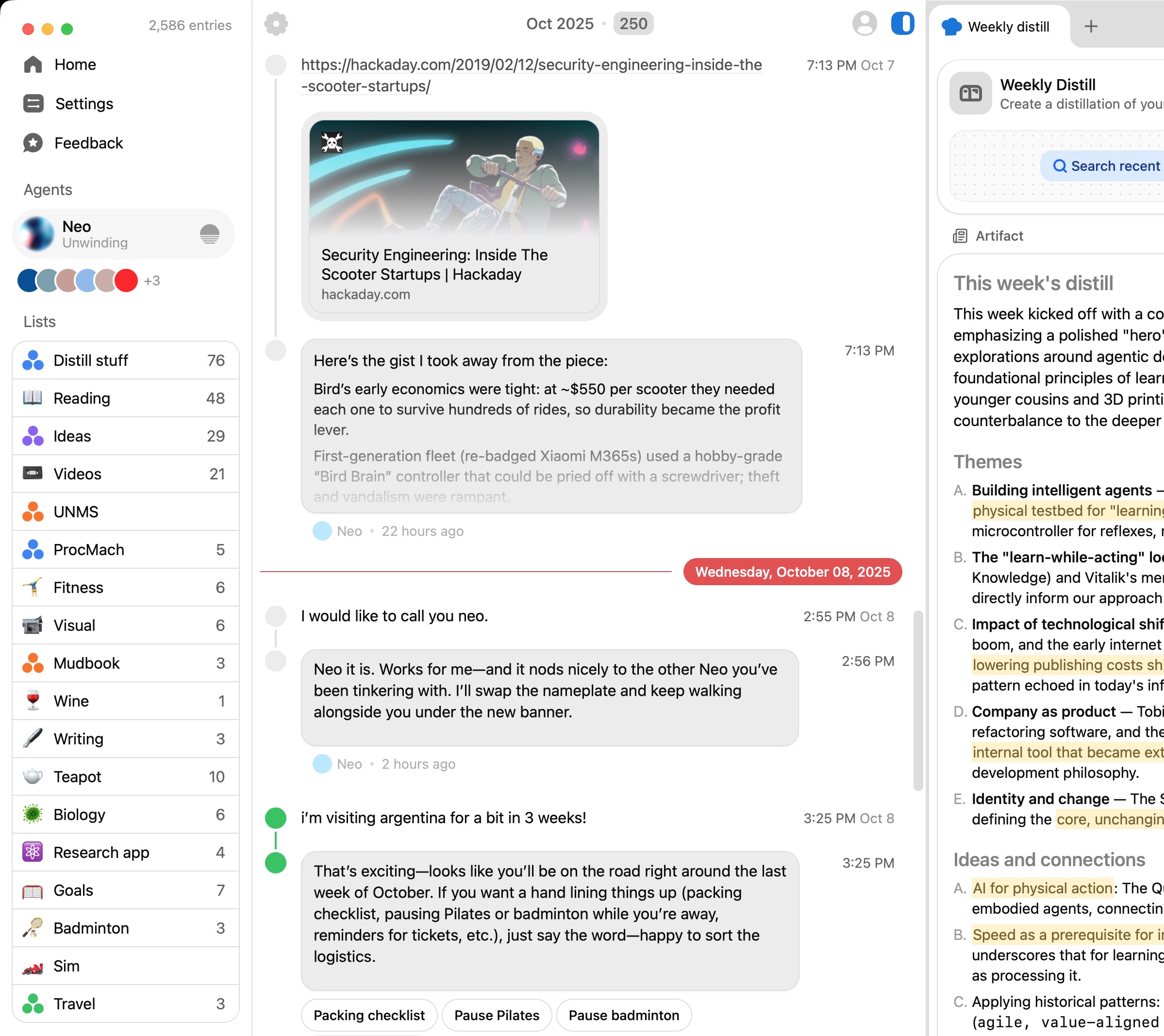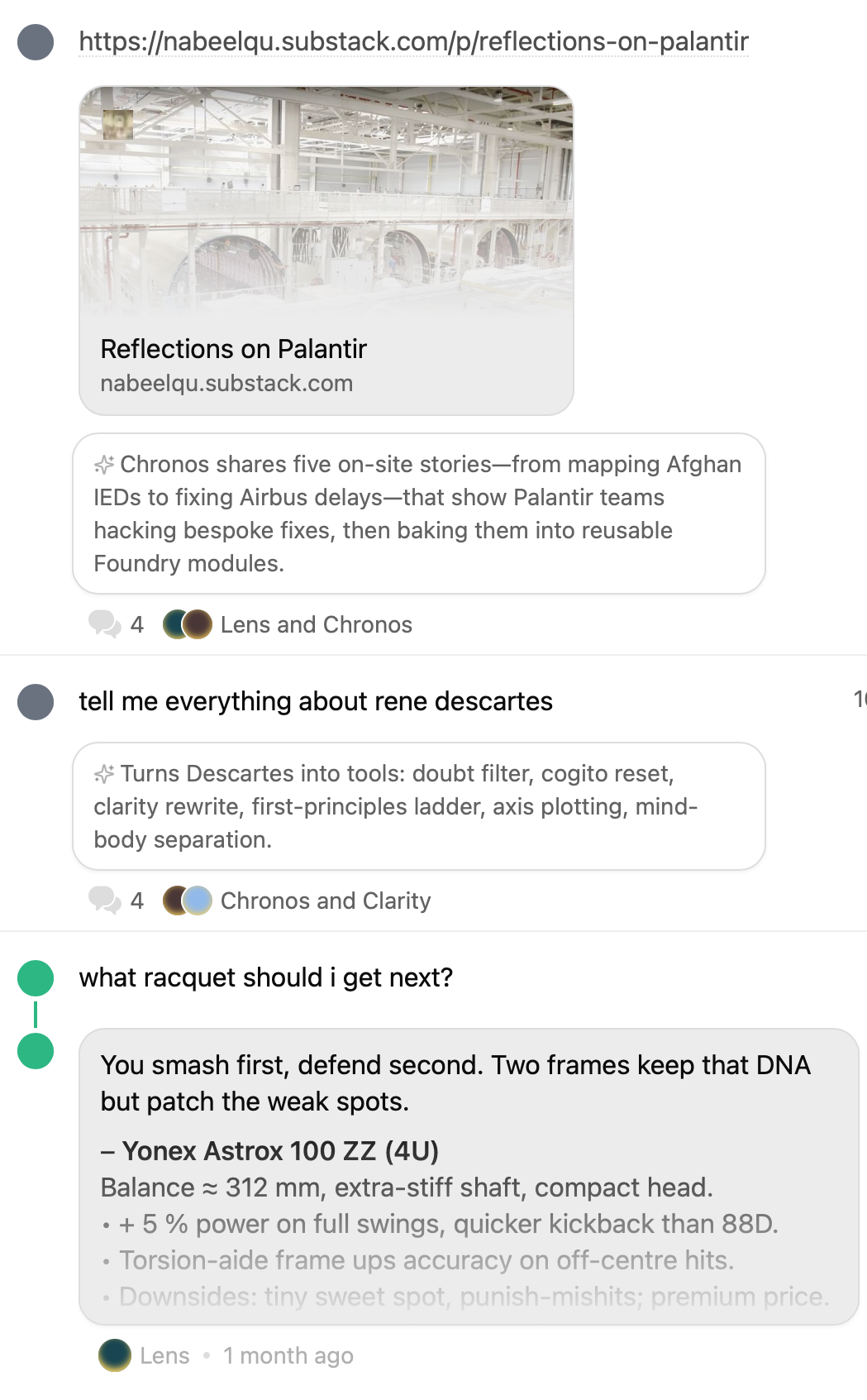For macOS & iOS
Capture once. Distill forever.
The insight-to-action loop for people who think for a living.
Request an invitation,
Distill is in limited access.
Distill is in limited access.

For reflection
For productivity
For memory
For clarity
Great ideas start in quiet places, welcome to your private think space.
Built for flow
Fast, modern mobile and desktop apps that work offline
Private by design
Stored on your device and syncs with end-to-end encryption
Works with AI
Intelligent agents that think with you and organize your vault
Speak to journal
Dictate your ideas and thoughts effortlessly
Capture effortlessly
Text, links, photos, screenshots, and more
With best-in-class AI
Your personal think tank
Intelligent agents that organize and enhance your thinking. Your intellectual force multiplier.

What are you thinking?
gpt-5 is out! should we switch you to it?
Nova is working
Nova is scanning 132recent entries to understand your context and checking 8 lists for relevant topics.
Found mentions of ChatGPT in your vault for additional context. Distill is using AI to analyze patterns and suggest relevant connections.
Added entry to ideas
Searching the web for openai gpt-5
They watch your threads, spot patterns, and do the groundwork you don't have time for— mapping connections, organizing lists, and surfacing the right context on cue.
Agents engage with you
Guide you towards your goals
Auto-organize entries into lists
Connect the dots across threads
Read and summarize links
Sees your screenshots
Planner
From insights to action
Agents help you break plans down, manage todos, and keep everything moving.
Overdue
Review quarterly budget report
Review and provide feedback on the Q4 budget analysis prepared by the finance team.
Yesterday · 2:00 PM
Today
40-min Zone-2 jog / easy spin
Perform a 40-minute Zone-2 jog or easy spin. Maintain a pace where you can converse in full sentences.
Today · 06:00 AM↻Repeats weekly
Team standup meeting
Daily sync with the team to discuss progress and blockers.
Today · 9:00 AM
No due date
Draft the first cut — 90-min rough draft block
Feedback loop — sit with Alex and refine the draft
Badminton practice
Checklists
Scheduled events
Repeating tasks
Capture an idea, sketch a plan, or think out loud–your agents turn it into an actionable roadmap without disrupting your flow.
Use cases
Who uses it?
Distill works for anyone who needs to keep their best thinking alive- from executives to researchers to creators.
Decision logging
Record key choices and the reasoning behind them, so you can revisit the ‘why’ at any time.
Idea tracking
Capture sparks of inspiration before they fade and connect them to ongoing work.
Weekly reviews
Reflect on the past week’s shifts, wins, and challenges to plan your next moves.
Story building
Develop narratives or arguments over time by adding and refining entries in a thread.
Progress tracking
Keep a living record of milestones, blockers, and updates across projects.
Goal setting
Define clear objectives and keep them visible as your work evolves.
Action planning
Turn insights and ideas into a prioritized list of next steps.
Strategy reviews
Assess current direction by surfacing shifts, risks, and opportunities.
Research synthesis
Convert scattered findings into clear, connected insights.
Meeting prep
Walk into discussions with the relevant context and decisions at hand.
Content outlining
Shape captured thoughts into structured drafts for writing or presentations.
Copyright © 2025 UNMS Technologies Corp.
All rights reserved. Terms of Service & Privacy Policy.